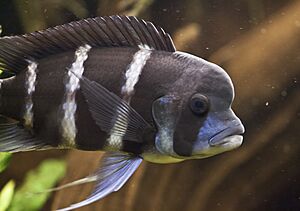Front Cichlid facts for kids
Quick facts for kids Front Cichlid |
|
|---|---|
 |
|
| Scientific classification | |
| Synonyms | |
|
The Front Cichlid, also known as Cyphotilapia frontosa, is a cool fish from Lake Tanganyika in East Africa. It's a special kind of fish because it's endemic to this lake, meaning it's found nowhere else in the world! Its scientific name, Cyphotilapia, comes from Ancient Greek words meaning "curved fish." And "frontosa" refers to its big forehead, which is a key feature of this fish.
Contents
What Does the Front Cichlid Look Like?
The Front Cichlid can grow quite large, up to about 33 centimeters (that's almost 13 inches) long! Even fish kept in aquariums can reach this size.
This fish has unique markings. It usually has five to seven black stripes going up and down its body. These stripes stand out against its white or blue body and head. Its fins often have a pretty blue color too.
One of the most interesting features of the Front Cichlid is a bump on its head, called a nuchal hump. This hump gets bigger as the fish gets older. Both male and female Front Cichlids can have this hump, but sometimes it's a bit larger on the males.
These fish are known for living a long time. They can live for over 25 years!
Different Colors and Types
Like many fish found in Lake Tanganyika, the Front Cichlid has different color types. This happened because groups of these fish lived separately for a long time. Over time, they developed slightly different colors and patterns.
Where Do Front Cichlids Live?
The Front Cichlid lives only in Lake Tanganyika in East Africa. It's found mostly in the northern part of the lake. A very similar fish, Cyphotilapia gibberosa, lives in the southern part.
These fish usually live in deeper waters, about 30 to 50 meters (100 to 160 feet) below the surface. But in the early morning, they swim up to shallower areas to find food. They like to eat smaller fish that swim in groups, like Cyprichromis species.
Keeping Front Cichlids in Aquariums
If you want to keep Front Cichlids as pets, you need to make sure their tank is just right. They need the water temperature to be between 25 and 30 degrees Celsius (77 to 86 degrees Fahrenheit). They also need lots of dark places and caves to hide in. This makes them feel safe and comfortable, just like their natural home in Lake Tanganyika.

